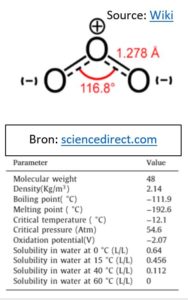Recent studies confirm the extra benefits from the combination of ozonation with sonification and/or nano-bubble infusion.
About Ozone:
Ozone is a naturally occurring gas containing 3 oxygen atoms. It is made by breaking oxygen molecules (O2) into atoms by a coronal discharge or the sun’s UV ray’s. Single oxygen atoms are not stable and regroup back into di-atomic oxygen (O2) molecules. During this recombination stage some atoms will regroup into loosely bonded tri-atomic oxygen (O3). This new molecule is called Ozone and is at atmospheric pressure a pale blue gas with a pungent smell. Due to the loose bond in this oxygen molecule, ozone is a very strong oxidant and an ideal chemical-free purification and a disinfecting agent.
Disinfection by O3 occurs through the rupture of the cell wall and is more efficient than Chlorine.
At a concentration of 0.4 ppm with an exposure time of 4 minutes, it has been shown to kill any bacteria, mold, fungus and inactivate viruses.
Some typical Dosages and Reaction Times:
- Aspergillus Niger (black Mount): Destroyed by 1.5 to 2 mg/1.
- Bacillus Bacteria: Destroyed by 0.2 mg/1 within 30 seconds
- Bacillus Anthracis: Causes anthrax in sheep, cattle and pigs. A human pathogen. Ozone susceptible.
- Clostridium Bacteria: Ozone-Susceptible.
- Clostridium Botulinum Spores: Its toxin paralyzes the central nervous system, being a poison multiplying in food and meals. 0.4 to 0.5 mg/1.
- Diphtheria Pathogen: Destroyed by 1.5 to 2 mg/1.
- Eberth Bacillus (Typhus abdominalis): Destroyed by 1.5 to 2 mg/1.
- Echo Virus 29: This virus most sensitive to ozone. After a contact time of 1 Minute at 1 mg/1 of ozone, 99.999% killed.
- Escheriachia Coli Bacteria (from feces): Destroyed by 0.2 mg/1 within 30 seconds.
- Encephalomyocarditis Virus: Destroyed to zero level in less than 30 seconds with 0.1 to 0.8 mg/1.
- Enterovirus Virus: Destroyed to zero level in less than 30 seconds with 0.1 to 0.8 mg/1.
- GDVII Virus: Destroyed to zero level in less than 30 seconds with 0.1 to 0.8 mg/1.
- Herpes Virus: Destroyed to zero level in less than 30 seconds with 0.1 to 0.8 mg/1.
- Influenza Virus: 0.4 to 0.5 mg/1.
- Klebs-Loffler Virus: Destroyed by 1.5 to 2 mg/1.
- Poliomyelitis Virus: Kill of 99.999% with 0.3 to 0.4 mg/1 in 3 to 4 minutes.
- Proteus Bacteria: Very Susceptible.
- Pseudomonal Bacteria: Very Susceptible.
- Rhabdovirus Virus: Destroyed to zero level in less than 30 seconds.
- Salmonella Bacteria: Very Susceptible.
- Staphylococci: Destroyed by 1.5 to 2 mg/1.
- Stomatitis Virus: Destroyed to zero level in less than 30 seconds with 0.1 to 0.8 mg/1.
- Streptococcus Bacteria: Destroyed by 0.2 mg/1 within 30 seconds
(photocatalytic) Ozonation in combination with sonification or nano-bubble infusion allows benefits for even more applications:
– Slugde reduction and solubilization
– Removal of organic contaminants (biomass)
– COD and odor removal of dairy wastewater
– Kill micropollutants, pathogens and virussen in hospital wastewater
– Improve biodegradability and decline the concentration of heavy metals such as Pb As, Cd, and Cr from petrochemical wastewater.
– Decolorization of highly colored microalgae-based wastewater from piggery effluent.
– Eliminating of pharmaceuticals (antibiotics, estrogens, and neutral) and detoxification of the effluent wastewater.
– Removal of a large number of trace organic compounds such as pharmaceuticals, personal care products, and endocrine disruptors present in secondary wastewater effluents.
– Color removal from textile industry wastewater (colored dyes, surfactants, and toxic chemicals). Discharge of textile wastewater to the environment is very harmful to ecosystems as it is highly colored.
